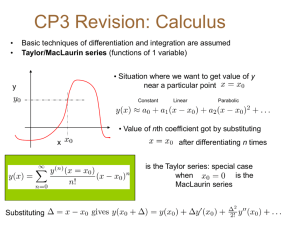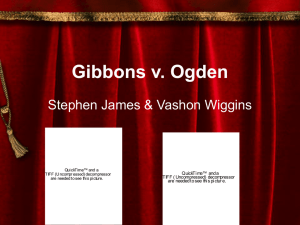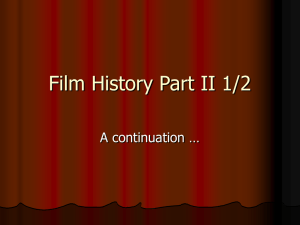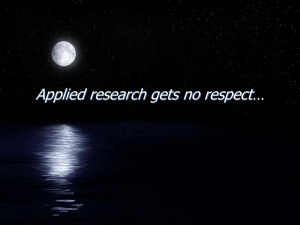Document
advertisement
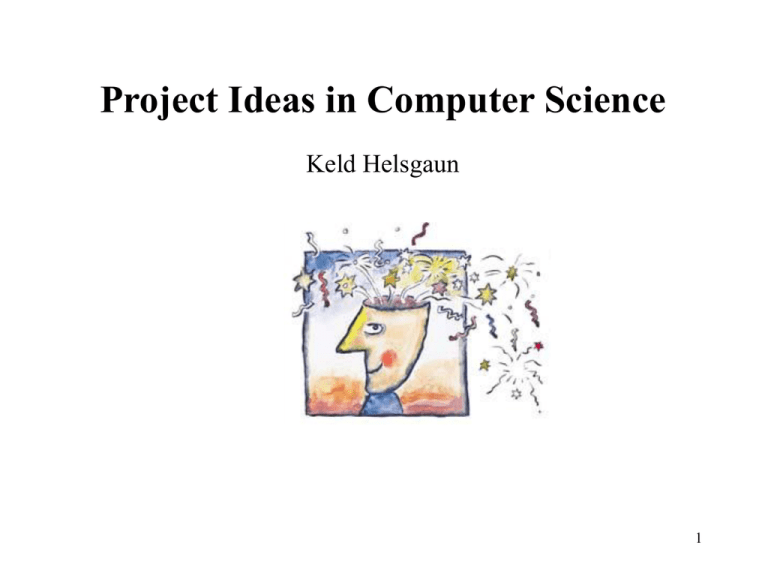
Project Ideas in Computer Science Keld Helsgaun 1 Keld Helsgaun Research: • Combinatorial optimization • Heuristic search (artificial intelligence) • Simulation • Programming tools Teaching: • Programming, algorithms and data structures 2 OPT-art 27486 points One out of 10110079 possible tours 3 Space filling curve A curve that passes every point of a square Sierpinski curve 4 QuickTi me™ and a TIFF ( Uncompressed) decompressor are needed to see thi s pi ctur e. Finding a tour Visit the points in the same order as they appear on the curve 5 Sierpinski - Mona Lisa O(n log n) time 6 Self-organizing neural networks O(n) time 7 Triangulized Mona Lisa 8 Delaunay triangulation For each triangle, the circumcircle does not contain any other points of the pointset 9 Genetic algorithms Darwin’s principle of evolution (“survival of the fittest”) may be used to construct effective optimization algorithms 10 Genetic algorithms An individual (chromosome) represents a candidate solution for the problem at hand. A collection of individuals currently "alive“, called population is evolved from one generation to another depending on the fitness of individuals, indicating how fit an individual is, in other words, how close it is to an optimal solution. At each evolutionary step, crossover and mutation (Genetic Operators) are applied on individuals, respectively. 11 Swarm intelligence Social insects - such as ants and bees - give us a powerful metaphor for developing decentralized problem solving systems consisting of simple cooperating agents. http://dsp.jpl.nasa.gov/members/payman/swarm/sciam_0300.pdf 12 Ant colony optimization QuickTime™ and a TIFF (Uncompressed) decompressor are needed to see this picture. Each ant leaves a trail of pheromones when it explores the solution landscape. This trail is meant to guide other ants. The trail will be taken into account when an ant chooses the next location to move to, making it more prone to walk the path with the strongest pheromone trail. 13 Timetabling Quic kTime™ and a TIFF (Unc ompres sed) dec ompres sor are needed to see this pic ture. Assign a number of events to a limited number of time periods. Course planning: Assign each lecture to some period of the week in such a way that no student is required to take more than one lecture at a time. International Timetabling Competition: http://www.idsia.ch/Files/ttcomp2002/ 14 Problem solving Write a general Java package for problem solving. For example, the package must be applicable to solving the so-called 15-puzzle: 11 9 4 15 1 3 0 12 7 5 8 13 2 10 ? 1 2 3 4 5 6 7 8 6 9 10 11 12 14 13 14 15 00 15 Rubik’s cube 16 Automatic theorem proving • Theorem proving: to show that a statement follows logically from some other statements • Automatic theorem proving: a mechanization of the proof 17 Example • Given the following 2 statements: All humans are mortal. Socrates is a human. • Show that we may conclude that: Socrates is mortal. 18 Project idea Development of a program that reads a series of logical statements, checks their correctness, and converts them into a form that may be used in an existing program for automatic theorem proving. Input: Logical statements in first order predicate Output: The statements transformed into disjunctive normal form Subjects: Syntax, semantics and translation 19 Data mining QuickTi me™ and a TIFF ( Uncompressed) decompressor are needed to see thi s pi ctur e. Analysis of large data sets with the purpose of finding meaningful patterns in the data. Example: cluster analysis 20 Distributed algorithms Quic kT i me™ and a T IFF (Unc ompres s ed) dec ompres s or are needed t o s ee thi s pi c ture. Application of xgrid for distributed solution of some chosen problem. QuickTime™ and a TIFF (Uncompressed) decompressor are needed to see this picture. Qu i ck Ti me ™a nd a TIF F (Un co mpre ss ed )d ec omp res so r a re ne ed ed to s ee th i s pi c tu re. 21 Simulation of a computer Development of a simulator for Donald Knuth’s MMIX machine. 22 Image compression QuickTime™ and a TIFF (U ncompressed) decompressor are needed to see t his picture. Compression of images be means of block truncation. 23 Symbolic differentiation Given a symbolic expression as the following: sin2(3x-2) + (3-2x)/(3+2x) Input the expression. Output the differential quotient with respect to x: -3/2(cos(6x-9) - cos(2x-3)) - 12/(3+2x)2 24 Representation of images QuickTime™ and a TIFF (Uncompress ed) dec ompres sor are needed to s ee this pic ture. Development of a program that, given a description as this one: Picture spiral = new Picture(50); spiral.plus(square).plus(spiral.origon(0,1).turned(10). magnified(0.95, 0.95)); Picture ram = new Picture(1); ram.plus(spiral).plus(spiral.origon(1,0).magnified(-1,1)); draws the picture 25 Wyvill, B.L.M. PICTURES-68 MK1. Software --- Practice and Experience, 7 (1977), pp 251--261. Computer vision Given a figure as the one shown below: Determine which edges that make up the outline of the figure ( ), and which inner edges that are oriented towards (+) or away (-) from the viewer. + + + + + + 26 Adventure games QuickT ime ™an d a TIFF ( Uncomp res sed) deco mpre ssor ar e need ed to see this pictur e. Development of an adventure game program in Java. Quic kTime™ and a TIFF (Unc ompres sed) dec ompres sor are needed to see this pic ture. 27 Optimization of simulation models QuickTi me™ and a T IFF (Uncom pressed) decom pressor are needed to see t his pict ure. Development of a general tool for optimization in connection with simulation. Example: Optimization of traffic lights. QuickTime™ and a TIFF (Uncompressed) decompressor are needed to see this picture. 28 The simulation language DEMOS A Java implementation of DEMOS (Discrete Event Modelling on Simula). 29 The game OCTI Don Green (2002) 30 Bioinformatics Quic kT i me™ and a T IFF (Unc ompres s ed) dec ompres s or are needed t o s ee thi s pi c ture. Involves: • Modeling of biological processes • Formulation of computational problems • Design and analysis of algorithms • Development and use of programs Focus on genetic sequence analysis. Example: How similar are two gene sequences? 31 Sorting by reversals QuickTi me™ and a TIFF ( Uncompressed) decompressor are needed to see thi s pi ctur e. Given a permutation og the integers 1 to n. Determine the shortest sequence of reversals that transforms the permutation into (1 2 3 ... n). Example: 43287156 43217856 12347856 12348756 12348765 12345678 5 reversals 32 Additional inspiration See the web page: www.akira.ruc.dk/~keld/teaching/Projektforslag • • Ten proposals in artificial intelligence Twelve mixed proposals (in Danish) 33 Contact Office 42.2 e-mail: keld@ruc.dk 34
